Queen Elizabeth II:
The most recognizable person in the world
Images of Queen Elizabeth II have been circulating the world for more than seven decades, making her one of the most recognizable faces in history.
Her reign saw the proliferation of color photography, the commercialization of television and the pervasiveness of the internet. She was photographed, painted and graffitied. Struck on coins, cast in iron, silk-screened onto T-shirts and fired onto plates. There’s even a Barbie doll in her likeness.
CNN explores some of the official and unofficial, classic and controversial images that turned Elizabeth II into the cultural icon she became.
In the palm of your hand
2 years on the throne
Designed by Mary Gillick, 1953
The Queen was 26 years old having just ascended the throne. The design is based on a portrait by the royal photographer Dorothy Wilding.
Credit: The Royal Mint
16 years on the throne
Designed by Arnold Machin, 1968
Machin also designed the portrait on UK stamps for the Royal Mail. For this portrait Machin had four sittings with the Queen.
Credit: The Royal Mint
33 years on the throne
Designed by Raphael Maklouf, 1985
The Queen is adorned with a diamond crown, pearl earrings and, for the first and only time, a necklace. Maklouf worked the portrait directly into clay during the two live sittings he had with the Queen.
Credit: The Royal Mint
46 years on the throne
Designed by Ian Rank-Broadley, 1998
Each coin designer is invited to add their initials, and “IRB” is visible just below the portrait.
Credit: The Royal Mint
63 years on the throne
Designed by Jody Clark, 2015
The Queen wears the same crown and earrings as the 1985 portrait. Clark’s portrait shows the Queen with a subtle smile, making it unique among the set.
Credit: The Royal Mint
Anyone who’s paid for anything in the UK with coins has seen one of five definitive portraits of the Queen.
Up until the 1970s there was an array of monarchs on UK coinage, but the decimalization of currency brought the UK in line with modernity. Out with the guineas and shillings, in with the pounds and pennies. From 1971 on, every coin produced has had the Queen’s likeness.
Royal Mint © Bank of England
The Royal Mint, which produces all UK coinage, estimates there are 27 billion coins currently in circulation.
That’s about 400 coins per UK citizen, or at least three coins for every person globally.
“She will have appeared on more coins than any other monarch in history,” said Chris Barker, a historian at the Royal Mint.
And that’s not all.
The Bank of England estimates more than 30 billion banknotes — or bills — featuring the Queen’s image have been produced during her reign.
Across the Commonwealth, the Queen is head of state for 15 countries.
Her image appears on stamps in Australia, Belize and Canada, for example.
Spin the globe, and select a dot to see some of the places where Queen Elizabeth II has been featured on coins and stamps.
See some of the places where Queen Elizabeth II has been featured on coins and stamps.
Kathiri sultanate (Yemen)

Oliver Dietze/DPA/AFP/Getty Images
Antigua and Barbuda

DeAgostini/Getty Images
Ascension Island

Oliver Dietze/DPA/AFP/Getty Images
Australia

Flavia Morlachetti/Adobe Stock
Bahamas

DeAgostini/Getty Images
Barbados

traveler1116/Getty Images
Basutoland (Lesotho)

Oliver Dietze/DPA/AFP/Getty Images
Belize

Comugnero Silvana/Adobe Stock
Canada

shaunl/Getty Images
Cayman Islands

traveler1116/Getty Images
Cyprus

mozcann/Getty Images
Falkland Islands

Empato/Getty Images
Gold Coast (Ghana)

Oliver Dietze/DPA/AFP/Getty Images
Grenada

Oliver Dietze/DPA/AFP/Getty Images
Hong Kong

traveler1116/Getty Images
Jamaica

Oliver Dietze/DPA/AFP/Getty Images
Kenya

Wylius/Getty Images
Malta

traveler1116/Getty Images
New Zealand

traveler1116/Getty Images
Nigeria

traveler1116/Getty Images
North Borneo (Sabah, Malaysia)

maybefalse/Getty Images
Pitcairn Islands

Oliver Dietze/DPA/AFP/Getty Images
Singapore

Getty Images
St. Kitts and Nevis

money & coins @ ian sanders/Alamy Stock Photo
St. Lucia

DeAgostini/Getty Images
Solomon Islands

Ivan Vdovin/Alamy Stock Photo
Uganda

Wylius/Getty Images
Updating the monarch’s portrait on UK coinage is a process that takes around a year, according to Barker, usually to “reflect the aging and changing of the monarch.”
Queen Elizabeth II had a profile update roughly every 16 years over her 70-year reign. The first portraits celebrate her youth, but artists throughout her tenure have had to capture the Queen’s likeness while being sensitive to her age.
Jody Clark designed the most recent portrait in 2015, when the Queen was 89.

Jody Clark standing by his design for the fifth definitive portrait of the Queen on UK coinage, in 2015.
Peter Macdiarmid/Getty Images

Queen Elizabeth II arrives by carriage to the State Opening of Parliament in 2004. It is one of the occasions of her wearing the diamond diadem and pearl earrings that appear on Clark’s portrait.
Ian Waldie/Getty Images
Clark’s portrait was chosen from around eight other submissions by artists invited to take part in a closed competition judged by the Royal Mint Advisory Committee.
The 2015 design shows the Queen with slightly upturned lips — a subtle smile — which makes it unique among the set of five portraits. The artist also had the freedom to choose the jewelry and headwear, or even none at all if he wanted.
“They're often given a fairly free rein … guidance-wise, it's pretty much 'Produce a portrait of the queen.' How they go about doing that is entirely up to them,” said Barker.
Mary Gillick, designer of the 1953 portrait, placed a simple laurel wreath around the monarch’s head. Upon hearing of this millinery decision, the Queen reportedly asked the artist not to make her too Julius Caesar-like, according to Barker.
Clark opted for a familiar diamond crown and paired it with pearl-drop earrings. Clark said he chose the regalia because he noticed the Queen wearing the same set regularly for the State Opening of Parliament.
“Coinage is very powerful, it says something about a society and a country from which it's from,” said Barker.

Queen Elizabeth II arrives by carriage to the State Opening of Parliament in 2004. It is one of the occasions of her wearing the diamond diadem and pearl earrings that appear on Clark’s portrait.
Ian Waldie/Getty Images
Visualizing a 20th century monarch
The Queen, like any major brand, went to great efforts to craft her public image. For each of her more than 200 official portraits, the artist was handpicked and their style approved by Buckingham Palace.
The setting, any surrounding objects, her attire and even her stance all contributed to the public’s impression of the person beneath the Crown.
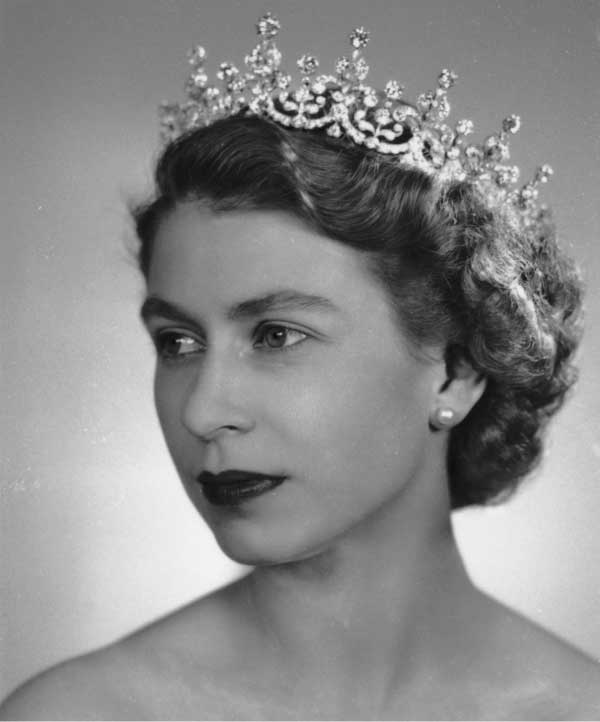
Portrait by Dorothy Wilding, 1952
© National Portrait Gallery, London
“I am … delighted that she commanded me to make the official portraits on the occasion of her accession to the throne.”Dorothy Wilding
The first portraits of the Queen, taken only 20 days into her reign, were by British society photographer Dorothy Wilding.
She was a natural choice, having been the official royal photographer (the first woman to hold that role) for the 1937 coronation of the Queen’s father, as well as other royal events.
Wilding was known for her unfussy, modern portraits on a clean white background.
The striking images of the Queen, who was only 25 years old, were the first ones ingrained in our visual culture — so much so that they endured as the basis for her image on postage stamps until 1971.
A year later in 1953, the famed British fashion photographer Cecil Beaton was invited to take the Queen’s official coronation photograph. The result was a portrait drenched in epic regal splendor.
Beaton had served as the official court photographer since 1937, so for three decades had recorded life events for the royal family, including the births of Elizabeth’s first two children, Prince Charles and Princess Anne.

The Queen wore a crown made of solid gold weighing almost five pounds (2.2kg)
Cecil Beaton/Camera Press/Redux
The coronation photo was taken at Buckingham Palace on an elaborate set that took two days to prepare.
The Queen was seated in front of a painted backdrop of Westminster Abbey dressed with thick drape curtains.
It was in the abbey not far from the palace where the Queen was crowned hours before, with Beaton as one of 8,251 guests, and millions more watching on television.
“On the one hand we are asked to be in awe of this enormous power and dignity and impressiveness, whilst also knowing that she's sitting on a stage with a fake backdrop,” said Rosie Broadley, senior curator of 20th century portraits at London’s National Portrait Gallery, which boasts 967 portraits of the Queen.
Beaton referenced historic royal portraiture to invoke the continuum of the dynasty. This nod toward stability was meaningful in a shattered, post-war Britain.
“This beautiful princess becoming a Queen was like a whole new era,” said Broadley.
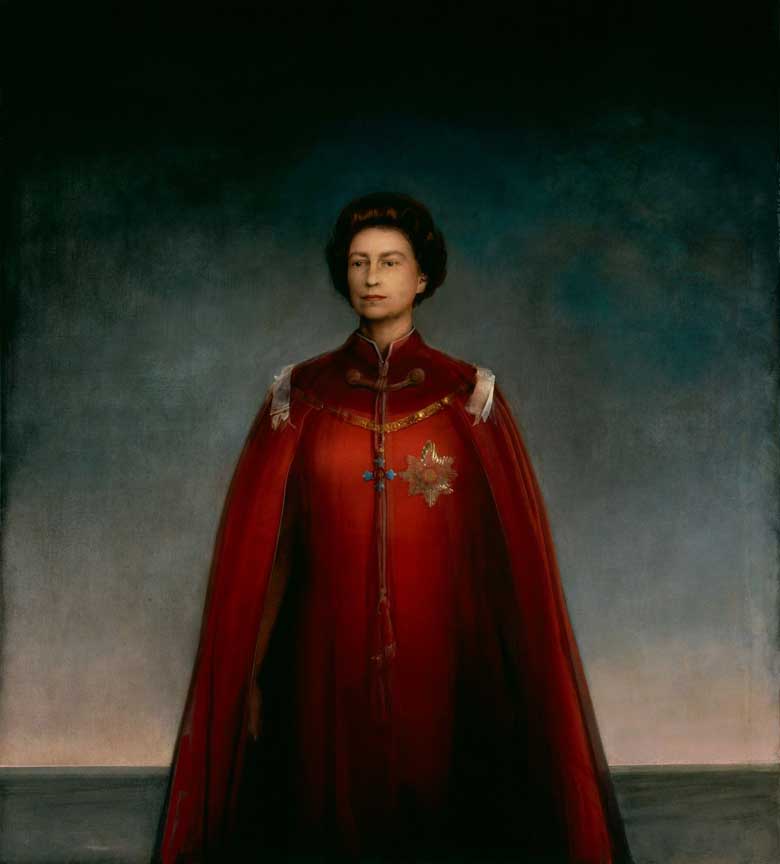
Queen Elizabeth II by Pietro Annigoni, 1969
© National Portrait Gallery, London
“I had made up my mind to show her in solitude, rather thoughtful and severe, profoundly human, and, at the same time, queenly without recourse to crowns or other symbols of regality.”Pietro Annigoni
In 1969, Pietro Annigoni, whose Italian renaissance-style emulated old masters like Leonardo da Vinci, was commissioned to paint the Queen for a second time.
While the first portrait, 15 years prior, portrayed the Queen standing strong and looking to the future, the second showed her with a vacant expression and in isolation.
"It has this kind of monumental power, and the fact that it doesn't have any background or obvious setting makes it quite timeless,” said Broadley.
“The late 60s and 70s were particularly difficult for the royal family. Society was changing rapidly, modernizing. The value systems were being turned on their heads. So her place as head of this society was being questioned increasingly,” added Broadley.
Britain was undergoing a cultural revolution and rejecting the status quo. In 1969, rock-and-roll icon John Lennon, of the Beatles, notably returned an honorary medal from the Queen as an act of protest. From music and fashion, to the end of state-mandated military service and even the widespread availability of the contraceptive pill, society was changing.
“More people watched the Queen having a barbecue than watched man landing on the moon.”Robert Hardman on the 1969 documentary series, “Royal Family”
In an attempt to open up and connect to the public, the Queen in 1969 allowed cameras into her home to film a documentary series called “Royal Family.”
“They weren't sure whether or not it was a good idea because it would take away that mystique and aura, and make them seem more relatable. And it sort of did and didn't work,” said Broadley.

The Queen has lunch in Windsor Castle with Prince Philip and her two teenage children Princess Anne and Prince Charles. The Queen allowed cameras to follow her and her family for a year for the fly-on-the-wall style documentary.
Hulton Archive/Getty Images
For the first time, people got to see the Queen in ordinary domestic life. She was filmed doing everyday activities like working from her home office, driving to the local shop and eating lunch with her family (on a full set of china with floral table arrangements in a gilded drawing room).
“People were just absolutely gobsmacked by this,” said royal biographer Robert Hardman in a video call with CNN.
The documentary was sold to TV stations around the world, and it had an estimated global audience of 350 million people, according to the BBC.
Its popularity secured a new image of the Queen in modern culture — without her wearing a crown and cape.
Remixing an icon
A weekend of festivities in the summer of 1977 marked the Queen’s Silver Jubilee, celebrating 25 years on the throne. That same weekend, a punk rock band called the Sex Pistols sailed a boat down the River Thames in London, blasting their new single “God Save the Queen” outside the Houses of Parliament until some of the boat’s party were arrested by the police.
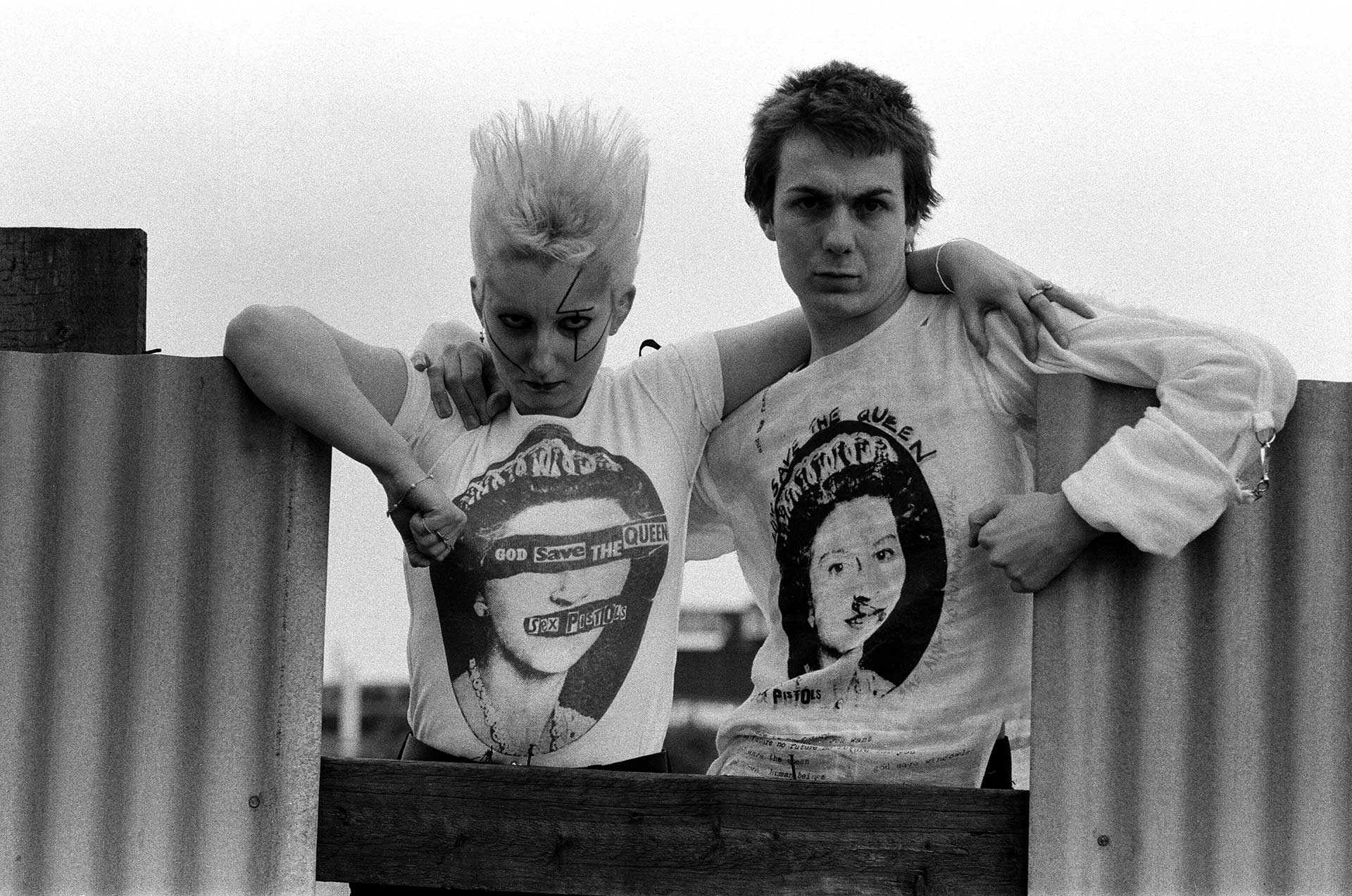
“God Save the Queen” T-shirts from “Seditionaries” boutique, a clothing store previously known as “Sex.” It was run by fashion designer Vivienne Westwood and her partner Malcolm McLaren, who was also the manager of the Sex Pistols.
Daily Mirror/Mirrorpix/Getty Images
The song went on to become the English anti-establishment punk anthem of the era. A new generation was openly rejecting the status quo and the monarchy was a powerful symbol to rebel against.
Artist Jamie Reid created the Sex Pistols’ unique punk aesthetic featuring torn paper and ransom-note-style lettering. The single cover he created for “God Save the Queen” remixed the Queen’s Silver Jubilee portrait with the song title and the band name covering her eyes and mouth. Reid also made another version of the cover art with a safety pin through the Queen’s lips next to the words: “She ain’t no human being.”
Click diamonds below to compare Queen portraits
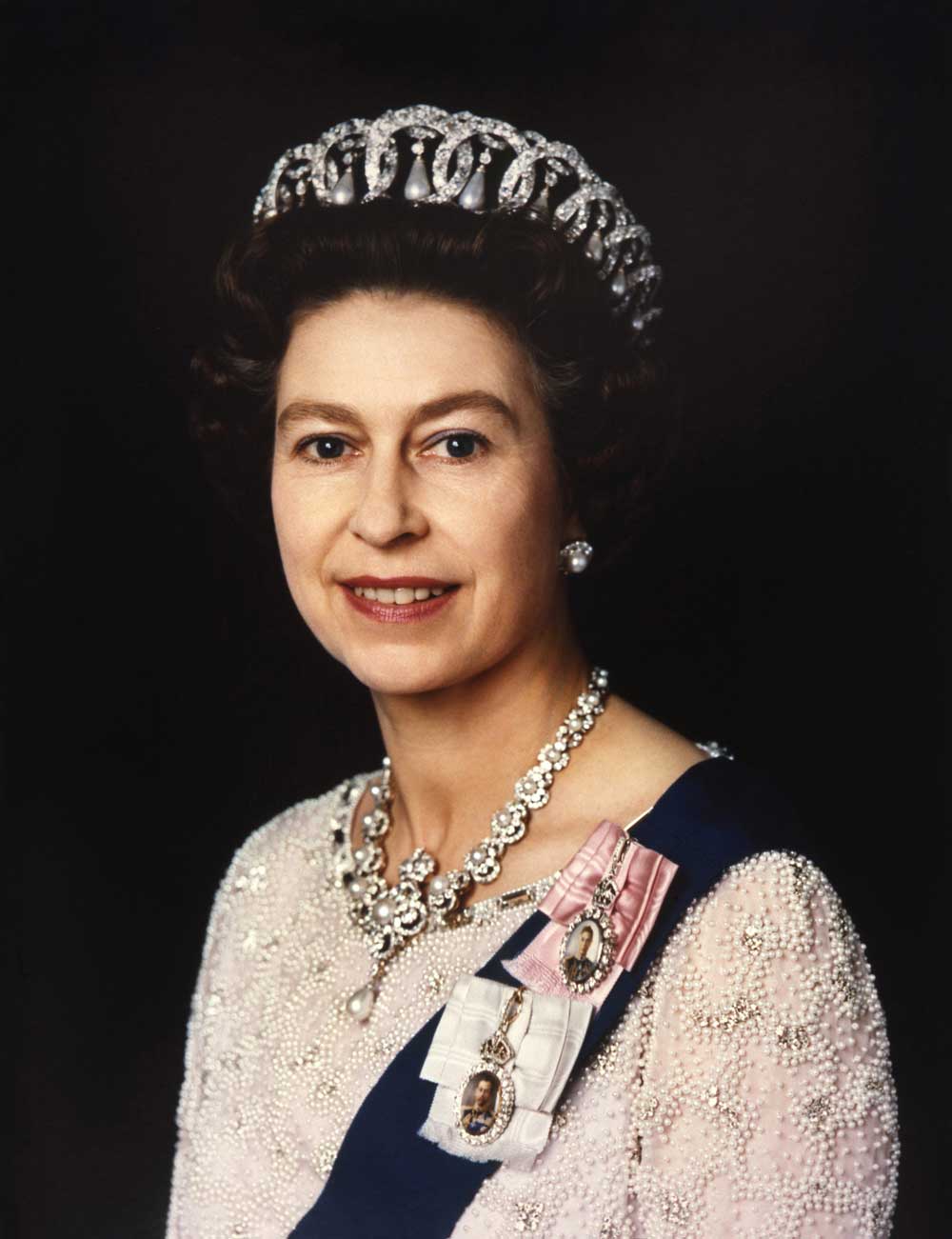
Peter Grugeon
1975
This portrait was used in 1977 as the official photo for the Queen’s Silver Jubilee two years after it was taken. The Queen wears the blue Garter Riband sash with images of her father and grandfather.
Peter Grugeon/Camera Press/Redux

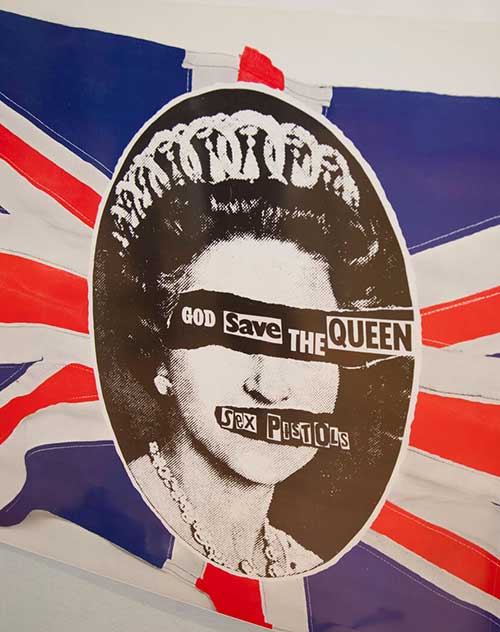
Jamie Reid
1977
Jamie Reid created this original artwork for the cover of “God Save the Queen,” featured here at Christies auction house. Reid and the manager of the Sex Pistols, Malcolm McLaren, had attended art school together.
Michael Kemp/Alamy
“From 1977 when Sex Pistols got God Save the Queen to No. 1, there was genuine working class support of these 'anti' monarchy sentiments,” Reid said in a handwritten letter response to CNN’s interview request for this story.
In the same letter, Reid also talks about the tension between “them 'the privileged' & us 'the underclass.’”
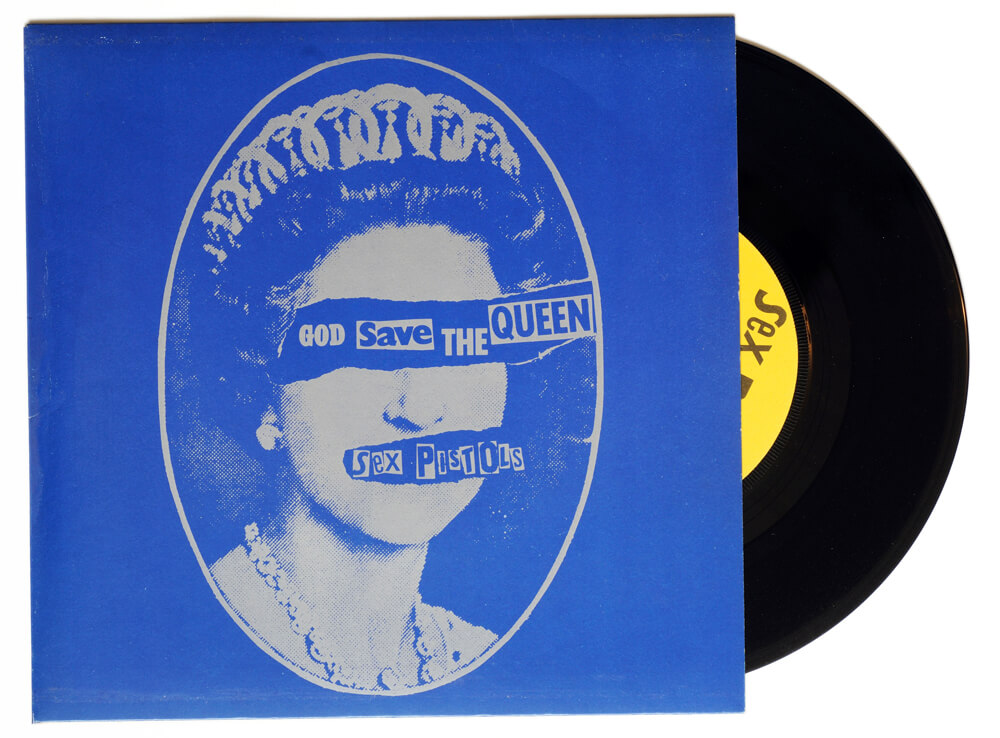
”God Save the Queen” vinyl by the Sex Pistols.
CBW/Alamy
The song was so popular that it officially made it to No. 2 on the UK music charts, despite it having been banned by commercial radio, the BBC and some record stores.
Click diamonds below to compare Queen portraits

Peter Grugeon
1977
Official portraits like this by Grugeon are “so devoid of personality that they become ripe for reinterpretation,” said Broadley, of London’s National Portrait Gallery. She continued, “It just becomes a cipher for all sorts of artists' imaginings.”
Peter Grugeon/Camera Press/Redux


Andy Warhol
1985
As part of the “Reigning Queens” series, Warhol also made portraits of Queen Beatrix of the Netherlands, Queen Ntombi Twala of Eswatini and Queen Margrethe II of Denmark.
Ian Gavan/Getty Images
Renowned visual artist Andy Warhol took the same photo of the Queen that Reid remixed and a decade later appropriated it for his 1985 “Reigning Queens” series of prints.
The pop artist used his signature photo-silkscreen technique to mass produce dozens of copies of Queen Elizabeth II, just like he turned everyday commodities such as Campbell’s soup cans into commentary on capitalist society.
“It's almost like he’s given her the stamp of approval somehow. He has embraced the Queen as part of 20th century celebrity,” Broadley said of Warhol.
“I want to be as famous as the Queen of England.”Andy Warhol
Celebrity and fame was a strong theme that ran throughout his work and he became prolific at elevating already-famous people, like Hollywood star Marilyn Monroe, to symbolic status.
“There's a sort of a distancing effect with the planes of color. She's still a mystery. It plays into this idea of the royal mystique,” added Broadley.
For the Queen’s 60-year Diamond Jubilee in 2012, Warhol’s prints made it full circle. The Royal Collection, a trust held by the Queen, purchased four Queen Elizabeth II prints from the Royal Edition, an exclusive print run sprinkled with “diamond dust” — finely crushed glass making the artwork “sparkle.”

The Justin Mortimer portrait of Queen Elizabeth II on display at “The Queen: Art and Image” exhibition in 2012.
Peter Muhly/AFP/Getty Images
The 1990s was a tough decade for the Queen. Three of her four children divorced, her home Windsor Castle went up in flames with more than 100 rooms damaged or destroyed. And she came under an enormous amount of public criticism for her response to Princess Diana’s tragic death in a car crash in Paris.
Mortimer’s portrait of a disembodied Queen came in 1998 — just after these events — as a commission by The Royal Society for the Encouragement of the Arts.
"I felt she was from another era. … I don't have anything in common with her apart from being English.”Justin Mortimer in an interview with the Wall Street Journal in 2011
Mortimer’s more recent work features dark, dystopian landscapes often hinting at disaster. But at the time of painting the Queen, he was a young portrait painter only six years out of art school.
It's not all capes and crowns
Queen Elizabeth II wearing a selection of purple outfits between 1991 and 2012.
David Rose/WPA Pool/Getty Images, Julian Herbert/ALLSPORT/Getty Images, Stefan Rousseau/AFP/Getty Images, Jerome Delay/AFP/Getty Images, Chris Jackson/WPA Pool/Getty Images
The Queen’s outfits were tailor-made and usually planned months — if not years — in advance. Sure, the Crown jewels helped her regal image, but when the monarch carried out meet-and-greets in recent years, she was often seen in a bright two-piece suit with matching coat and hat, topped off with gloves.
Bright, block colors meant Queen Elizabeth II could be seen from afar by anyone trying to catch a mere glimpse. The hat kept her hair looking regal despite the wind and provided shade from the sun (or more likely drizzle, if it’s in the UK). Low-heeled pumps were selected for comfort, as were gloves.
The Queen was also known to have a bit of fun with her image.
When London hosted the summer 2012 Olympic games, the sovereign agreed to appear alongside James Bond in a scene-stealing moment during the opening ceremony, where she appeared to jump out of a helicopter and parachute into the stadium.
Of course — and only slightly disappointingly — these were actors. But as the real then 86-year-old Queen walked into the stadium to take her seat, straight-faced with only a fleeting, knowing smile, the crowd roared with applause.

For the opening ceremony of the London 2012 Olympic Games, the Queen and James Bond seemingly jump out of a helicopter and parachute into the Olympic stadium.
Cameron Spencer/Getty Images
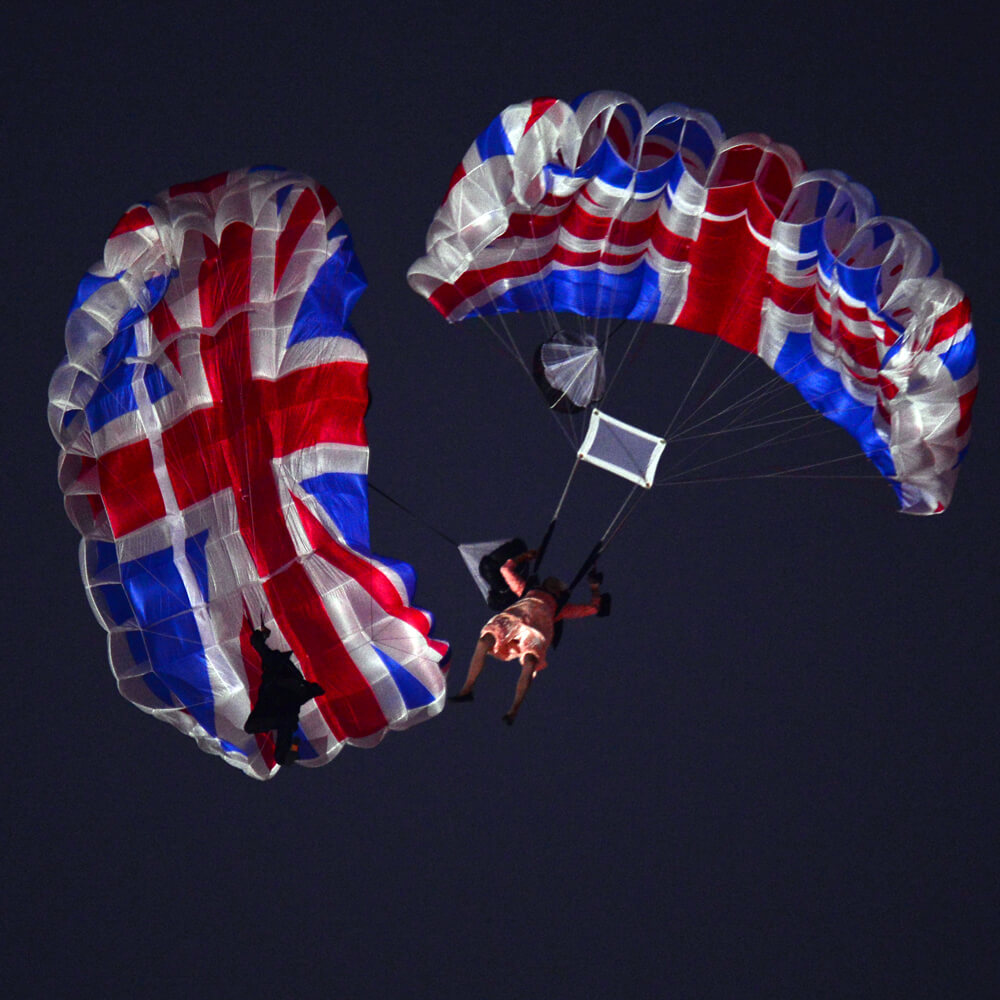
Olivier Morin/AFP/Getty Images

Daniel Berehulak/Getty Images
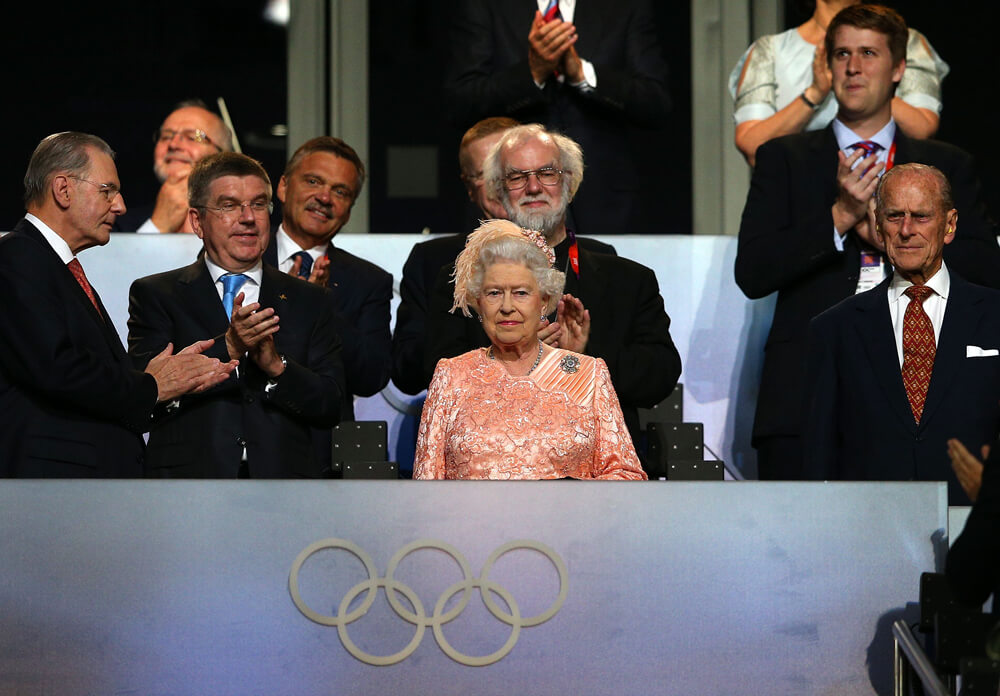
The Queen in the Olympic Stadium amidst applause.
Cameron Spencer/Getty Images
Beyond an icon
In her sunset years, the Queen was willing to let unconventional portraits reveal more of her as a person.
Lucian Freud was one of the most established figurative painters in Britain. His warts-and-all portraits of friends, family and himself were the result of months-long sittings at his studio.
When Freud painted the Queen it was in a picture conservation studio at St. James Palace, during a limited number of sittings between May 2000 and December 2001 — lightning fast by his standards.
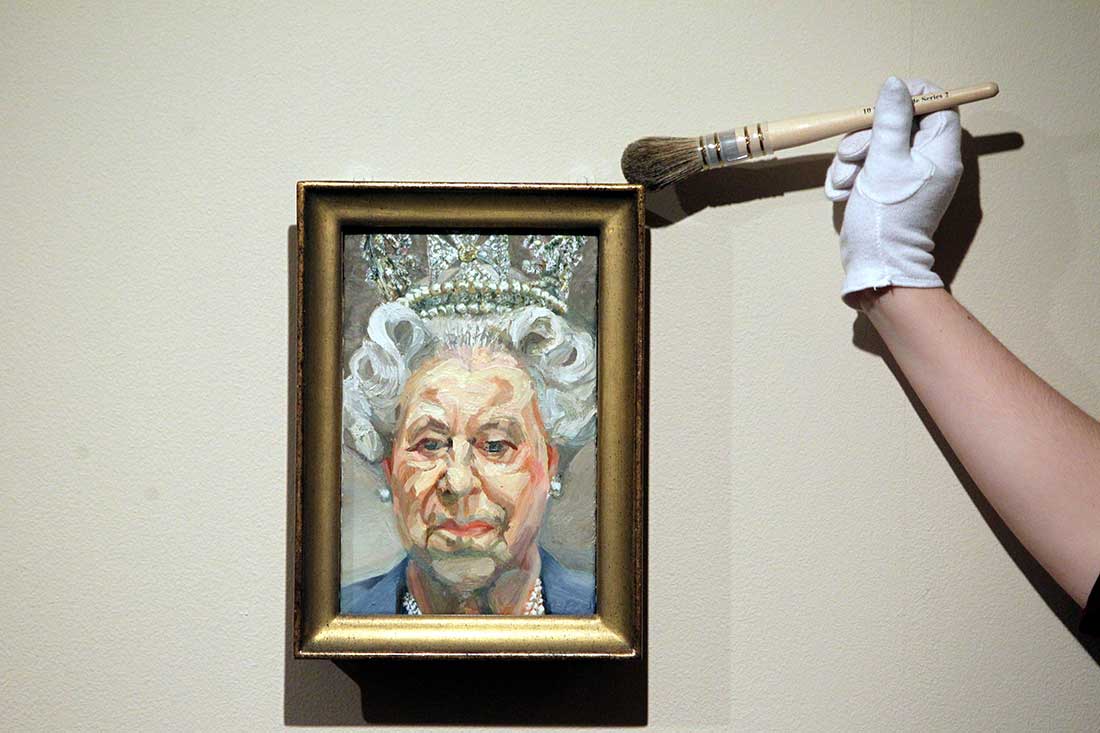
Lucian Freud’s portrait of the Queen on show as part of “The Queen: Portraits of a Monarch” exhibition at Windsor Castle.
Steve Parsons/PA Images/Getty Images
On a tiny canvas, Freud made a tight crop of the Queen’s head that filled the entire space with thick, fleshy brush strokes.
Later he had the canvas extended to add a diamond crown, perhaps to make the Queen more “recognizable,” according to the Royal Collection Trust, but the overall effect of his work is still laid bare.
“You probably think I’m going incredibly slowly, but in fact I’m going at ninety miles an hour, and if I go any faster the car might overturn.”Lucian Freud
“It's quite shocking and surprising. People almost think it's intrusive, to show the Queen like that,” said Broadley, of London’s National Portrait Gallery.
The portrait divided opinion among art critics, with some describing it as “honest, stoical” while others thought: “Freud should be locked in the Tower for this.”
Former US President George W. Bush — also a keen painter — spoke about this portrait to biographer Hardman in his most recent book, “Queen of Our Times.”
“’Anyone who allows himself to be painted by Lucian Freud’, [Bush] said, ‘that, to me, speaks of a great deal of confidence. You've got to be a very confident person to open yourself up to that particular lens,’” Hardman recounted to CNN of the President’s anecdote.

“Lightness of Being,” by Chris Levine, 2004
“If my work is about anything, it's about just creating moments of stillness and meditative refuge.”Chris Levine
In 2012, artist Chris Levine released a photograph of the Queen with her eyes shut, a serendipitous outtake from a sitting with the Queen eight years earlier.
“It operates at a different level … There's just something about the feeling of that image which touches people,” Levine told CNN on a video call from his studio in Hampshire, southern England.
Levine was commissioned by the island of Jersey along with holographer Rob Munday to do a portrait to mark 800 years of allegiance to the Crown. The official image selected was a black and white hologram of the Queen looking into the camera titled “Equanimity,” which went on display at the Jersey Heritage archive in 2004.
The 3D portrait was a move to bring a modern visual language to the oeuvre of Queen’s portraiture. “I wanted to give it some kind of evolutionary step,” Levine said.

“Equanimity / Queen Elizabeth II” by Chris Levine (artist) and Rob Munday (holographer)
© Jersey Heritage Trust, 2004
At the time, portraits were not a major part of his body of work. His practice was based on experimenting with light and light-based technologies. There is a distinctly spiritual element to Levine’s work that he attributes to his practice of meditation.
“I was very conscious of Her Majesty's breathing, so as the camera took the time to do a pass, I was standing next to her with the shutter control and timing it, so that we would tune into her rhythm of breathing,” Levine added.
Like most of the artists commissioned to do a portrait of the Queen, Levine was able to style her clothes and choose her regalia. Prior to the sitting, he had a session with the Queen’s personal assistant and dresser.
“I got to go through the Crown Jewels. Some of them are really big and uber bling, and I wanted something really simple,” Levine recalled. Like the artist Freud and coin designer Clark, he opted for the diamond diadem, which the Queen often wears to the State Opening of Parliament.
After two sittings with the Queen, Levine remembers how easy she was to engage with.
“We got on really well, and she did ask questions about the process,” he said. At one point Levine’s assistant was explaining how they would scan the Queen, saying, “it's like having your passport photograph taken ma'am,” to which the Queen replied: “One doesn't have a passport.”
"I declare before you all that my whole life, whether it be long or short, shall be devoted to your service."Queen Elizabeth II in a speech to the Commonwealth in 1947
Queen Elizabeth II's reign coincided with the rise of mass media and ease of travel, which enabled her to visit more than 100 countries. She met 12 serving US Presidents and was the monarch for 15 UK Prime Ministers.
Hardman accompanied the Queen on a 2010 trip to the United Arab Emirates, when he says he noticed a 1979 picture of the Queen and founding father of the nation, Sheikh Zayed al Nahyan, on the cover of school history books.
”It would be a bit like George Washington turning up today. This figure from history.” Hardman said.
Broadley said: “Because of the length of her reign, it's allowed her to become the icon that has superseded the success or failure of her reign.”
What made the Queen one of the most recognizable people in the world?
Longevity.